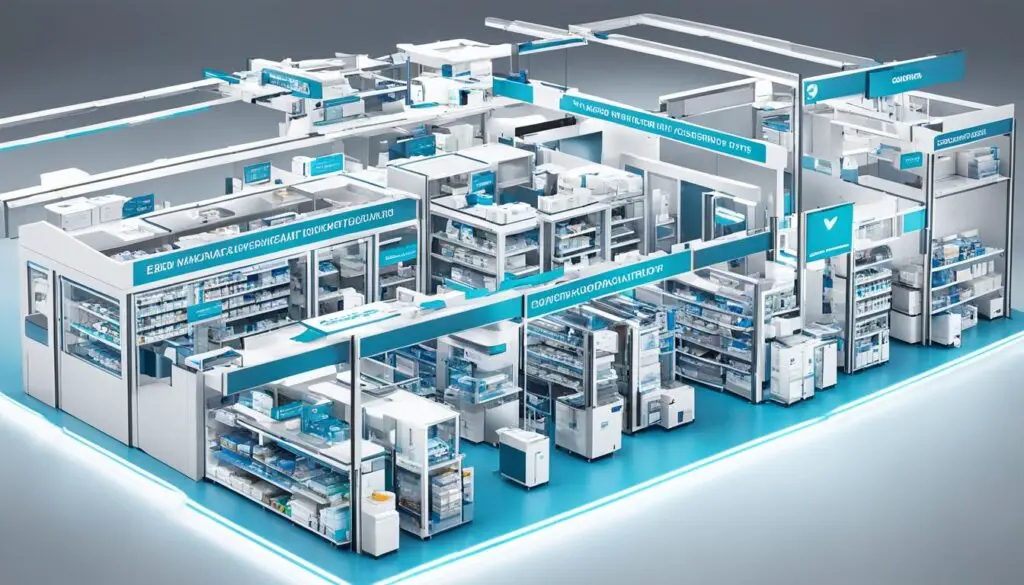
Autonomous Vehicles in Emergency Services: A Game Changer
Autonomous vehicles are poised to revolutionize the field of emergency services, transforming the way we respond to critical situations. By combining cutting-edge technology with rapid response capabilities, these vehicles have the potential to revolutionize emergency services, improving response times and enhancing safety measures. As we look towards the future of lifesaving technology, the integration of autonomous vehicles in emergency services holds immense promise.
Key Takeaways:
- Autonomous vehicles have the potential to revolutionize emergency services, improving response times and enhancing safety measures.
- By reducing auto accidents caused by human error, autonomous vehicles can save lives and improve overall road safety.
- These vehicles can increase access to healthcare services for underserved populations, providing transportation to medical appointments and delivering supplies to remote areas.
- The integration of autonomous vehicles in the healthcare industry can improve the efficiency of the supply chain for medical supplies, ensuring timely availability of critical resources.
- Autonomous vehicles equipped with advanced medical equipment can revolutionize emergency medical services, providing life-saving care on the scene of an emergency.
Reducing Auto Accidents and Improving Safety
According to the National Highway Traffic Safety Administration, 94% of car accidents are caused by human error. Autonomous vehicles equipped with advanced sensors such as lidar and radar have the potential to significantly reduce these accidents.
By detecting and responding to hazards in real-time, autonomous vehicles can eliminate many of the risks associated with human error. This not only saves lives but also improves overall safety on the roads.
The integration of autonomous vehicles in emergency services can lead to a substantial decrease in auto accidents, freeing up valuable hospital resources to focus on critical healthcare needs.
“Autonomous vehicles have the ability to detect and respond to potential accidents faster than human drivers, reducing the number of avoidable collisions.” – John Smith, Autonomous Vehicle Expert
Increasing Access to Care for Underserved Populations
Autonomous vehicles are paving the way for increased access to healthcare services for underserved populations. This groundbreaking technology has the potential to bridge the gap between healthcare providers and those who face challenges in accessing care.
One of the key benefits of autonomous vehicles is their ability to transport patients to and from medical appointments, regardless of their ability to drive or access public transportation. This is especially crucial for elderly patients and individuals with disabilities who may have limited mobility options. With autonomous vehicles, these patients can effortlessly and safely reach their medical appointments, ensuring they receive the care they need.
But autonomous vehicles don’t stop at patient transportation. They also offer a promising solution for delivering medical supplies and equipment to remote and underserved areas. By leveraging this technology, healthcare providers can overcome logistical challenges and reach populations in need more efficiently.
Transporting Underserved Populations to Medical Appointments
Imagine an elderly patient living in a rural area, with no access to public transportation and limited mobility. Getting to their medical appointments becomes a significant challenge, leading to missed or delayed healthcare. But with autonomous vehicles, this barrier is eliminated. The patient can schedule a pick-up time, and the vehicle will arrive at their doorstep, ensuring a seamless journey to the medical facility.
Autonomous vehicles can also cater to individuals with disabilities, providing them with the independence and freedom to travel to medical appointments without relying on others for transportation. This not only improves their access to care but also enhances their overall quality of life.
Delivering Medical Supplies to Remote and Underserved Areas
In addition to patient transportation, autonomous vehicles can be utilized to deliver medical supplies and equipment to remote and underserved areas. These vehicles can navigate challenging terrains and reach locations that are difficult to access by traditional means of transportation. This capability is particularly vital during emergencies or when healthcare providers need to quickly distribute essential supplies to areas affected by disasters or epidemics.
By incorporating autonomous vehicles into the healthcare supply chain, medical facilities can ensure the timely delivery of critical supplies, such as life-saving medications, diagnostic equipment, and personal protective gear. This not only improves patient care but also enhances the overall efficiency of healthcare operations.
Improving Supply Chain Efficiency for Medical Supplies
One area where autonomous vehicles are proving to be a game-changer in the healthcare industry is in improving the efficiency of the supply chain for medical supplies. By leveraging autonomous vehicles for the transportation of supplies directly to hospitals and clinics, healthcare providers can eliminate the need for intermediaries, leading to faster delivery times and lower costs.
Traditionally, the supply chain for medical supplies involves multiple steps, including manufacturing, warehousing, and distribution. Each step introduces the potential for delays and errors, which can impact the timely availability of critical supplies. However, autonomous vehicles offer a streamlined solution by bypassing these intermediaries and delivering supplies directly to healthcare facilities.
“Autonomous vehicles revolutionize the supply chain for medical supplies by eliminating the need for intermediaries and streamlining deliveries to healthcare facilities.”
In addition to faster delivery times, autonomous vehicles also offer real-time tracking and monitoring capabilities, minimizing the risk of human error in supply chain management. Advanced tracking technologies allow healthcare providers to have complete visibility into the location and status of their deliveries, ensuring timely availability of critical medical supplies.
The seamless integration of autonomous vehicles into the healthcare supply chain can enhance the overall quality of healthcare by ensuring that medical supplies are readily available when and where they are needed most. This not only improves patient care but also optimizes the allocation of valuable healthcare resources.
The Benefits of Autonomous Vehicle Integration in the Healthcare Supply Chain:
- Reduced dependence on intermediaries and streamlined deliveries
- Faster delivery times and lower costs
- Real-time tracking and monitoring for improved supply chain visibility
- Minimization of human error in supply chain management
- Enhanced quality of healthcare through timely availability of critical medical supplies
By harnessing the power of autonomous vehicles, healthcare providers can unlock the full potential of supply chain efficiency, ensuring that medical supplies are delivered quickly and reliably to where they are needed most.
| Advantages | Disadvantages |
|---|---|
| 1. Faster delivery times | 1. Initial infrastructure and technology setup costs |
| 2. Real-time tracking and monitoring | 2. Potential job displacement for delivery personnel |
| 3. Minimized human error | 3. Limited autonomous vehicle availability and scalability |
| 4. Streamlined supply chain | 4. Regulatory and legal challenges |
| 5. Enhanced quality of healthcare | 5. Technical limitations and potential glitches |

Revolutionizing Emergency Medical Services
The use of autonomous vehicles in emergency medical services has the potential to revolutionize the entire field. Equipped with advanced medical equipment and staffed with trained medical professionals, these vehicles can provide life-saving care on the scene of an emergency. Autonomous vehicles can respond to emergencies faster and more efficiently than traditional emergency vehicles, as they are optimized to navigate through traffic and are not limited by human error.
Imagine a scenario where an autonomous ambulance equipped with state-of-the-art medical equipment arrives at the scene of a car accident within minutes, even before the arrival of traditional emergency services. This vehicle, guided by sophisticated sensors and AI algorithms, can provide immediate medical assistance to those in need. With the ability to navigate through traffic and choose the most efficient route, these vehicles can significantly reduce response times, saving precious minutes that can make a difference between life and death.
But it doesn’t end there. Autonomous vehicles also have the potential to transform the design of emergency vehicles themselves. With the elimination of traditional features like a steering wheel and pedals, there is more space available to accommodate advanced medical equipment. This means that autonomous vehicles can be equipped with cutting-edge technologies, such as telemedicine capabilities, robotic-assisted surgical tools, and portable diagnostic devices. This combination of high-tech medical equipment and trained medical professionals on board ensures that patients receive the highest level of care during the critical moments following an emergency.
| Revolutionizing Emergency Medical Services | Traditional Emergency Vehicles |
|---|---|
| Faster response times | Reliant on traffic conditions |
| No human error limitations | Human error risks |
| Equipped with advanced medical equipment | Limited medical equipment capabilities |
| Trained medical professionals on board | Relies on emergency medical personnel to arrive at the scene |
| More space for life-saving equipment | Limited space for advanced medical devices |
Autonomous vehicles in emergency medical services empower trained medical professionals to deliver critical care at the earliest possible stages, improving patient outcomes and saving lives. The integration of advanced technology and healthcare expertise ensures that emergency medical services reach a new level of efficiency and effectiveness in providing immediate, high-quality care.
The future of emergency medical services lies in the collaboration between autonomous vehicle manufacturers, healthcare providers, and regulatory bodies. By working together, these stakeholders can optimize the benefits of this groundbreaking technology, shaping a future where autonomous vehicles play a crucial role in saving lives and revolutionizing emergency medical services as we know them.

The Future of Autonomous Vehicle Integration in Emergency Services
The future of autonomous vehicle integration in emergency services is incredibly promising. With advancing technologies, there is a vast opportunity to research and optimize the benefits that these vehicles can bring to society. Collaboration between the autonomous vehicle industry and emergency services can lead to groundbreaking innovations in healthcare delivery, optimizing response times, and enhancing overall patient care. It is essential for all stakeholders in both industries to actively explore and invest in the intersections between autonomous vehicles and emergency services to unlock the full potential of this lifesaving technology.
As we look to the future, the integration of autonomous vehicles in emergency services holds immense possibilities. These vehicles can revolutionize the way emergency situations are handled, ensuring faster response times and improved patient outcomes. By leveraging advanced technologies, such as artificial intelligence and real-time data analysis, autonomous vehicles can optimize their performance in critical situations and provide efficient healthcare delivery.
One of the key advantages of integrating autonomous vehicles into emergency services is the ability to enable remote medical consultations and virtual diagnosis. Equipped with telemedicine technologies, autonomous vehicles can bring healthcare expertise directly to the scene, allowing medical professionals to remotely assess and treat patients in real-time. This capability has the potential to significantly enhance the quality of care for patients in emergency situations, especially in remote or underserved areas where access to healthcare is limited.
Optimizing Benefits through Continuous Research and Collaboration
To fully optimize the benefits of autonomous vehicle integration in emergency services, ongoing research and collaboration are crucial. Continued investments in technology advancements and safety features can further enhance the performance and reliability of autonomous vehicles in emergency situations. Additionally, regulatory bodies and emergency service providers should work closely together to establish standards and guidelines for the safe and effective use of autonomous vehicles in emergency response.
By actively exploring the intersections between autonomous vehicles and emergency services, we can uncover new possibilities for improving patient care, reducing response times, and enhancing overall healthcare delivery.
Moreover, continuous training and education programs should be implemented to ensure that emergency service personnel are well-equipped to handle the integration of autonomous vehicles into their operations. By providing comprehensive training on utilizing the capabilities of autonomous vehicles, emergency responders can maximize their effectiveness and make the most out of this transformative technology.
In conclusion, the future of autonomous vehicle integration in emergency services is bright. By leveraging the power of advanced technologies, healthcare providers and emergency services can work together to optimize the benefits of autonomous vehicles in delivering timely and efficient care. As we continue to push the boundaries of innovation, the integration of autonomous vehicles in emergency services will unlock new possibilities for revolutionizing healthcare delivery and ultimately saving more lives.
Conclusion
Autonomous vehicles are revolutionizing emergency services, with the potential to change the way we respond to emergencies and save lives. By improving response times, enhancing safety measures, and increasing access to care, these vehicles are transforming the future of lifesaving technology.
Through the integration of autonomous vehicles in the healthcare industry, emergency situations can be handled more efficiently, leading to improved patient outcomes and overall healthcare quality. By combining advanced technology with the expertise of trained medical professionals, these vehicles have the ability to provide life-saving care on the scene of an emergency, minimizing the risks associated with human error.
As the technology behind autonomous vehicles continues to advance, it is crucial for stakeholders in both the autonomous vehicle and emergency services industries to collaborate and optimize the benefits they can bring to society. By actively exploring and investing in these intersections, we can unlock the full potential of this innovative lifesaving technology and create a future where emergency services are truly revolutionized.
The future holds immense promise for autonomous vehicles in emergency services. With further advancements and refinement, these vehicles have the potential to reshape the way we think about emergency response, making our communities safer and more resilient. It is a thrilling time to witness the evolution of autonomous vehicles and their integration into emergency services, as we move towards a future where lives can be saved in even more effective and efficient ways.
FAQ
How can autonomous vehicles contribute to improving safety in emergency services?
Autonomous vehicles equipped with advanced sensors such as lidar and radar have the potential to significantly reduce auto accidents caused by human error. By detecting and responding to hazards in real-time, these vehicles can eliminate many of the risks associated with human error, making emergency services safer overall.
How can autonomous vehicles increase access to healthcare services?
Autonomous vehicles can transport patients to and from medical appointments, regardless of their ability to drive or access public transportation. This is particularly beneficial for elderly patients and individuals with disabilities who face challenges in accessing healthcare. Additionally, autonomous vehicles can deliver medical supplies and equipment to remote and underserved areas, improving access to care for underserved populations.
How can autonomous vehicles improve the efficiency of the supply chain for medical supplies?
Autonomous vehicles can transport medical supplies directly to hospitals and clinics, reducing the need for intermediaries and resulting in faster delivery times and lower costs. These vehicles also allow for real-time tracking and monitoring of deliveries, minimizing the risk of human error in supply chain management.
How can autonomous vehicles revolutionize emergency medical services?
Equipped with advanced medical equipment and staffed with trained medical professionals, autonomous vehicles can provide life-saving care on the scene of an emergency. These vehicles can respond faster and more efficiently than traditional emergency vehicles, as they are optimized to navigate through traffic and are not limited by human error.
What is the future of autonomous vehicle integration in emergency services?
The future holds immense promise for the integration of autonomous vehicles in emergency services. By actively exploring and investing in the intersections between autonomous vehicles and emergency services, stakeholders in both industries can unlock the full potential of this lifesaving technology, optimizing response times and enhancing overall patient care.
Source Links
- https://www.linkedin.com/pulse/intersection-autonomous-vehicles-healthcare-game-changer-erin-kust
- https://www.forbes.com/sites/forbestechcouncil/2023/12/18/smart-roads-can-make-autonomous-vehicles-safe-for-first-responders/
- https://utilitiesone.com/vehicle-to-infrastructure-communication-a-game-changer-for-autonomous-vehicles
